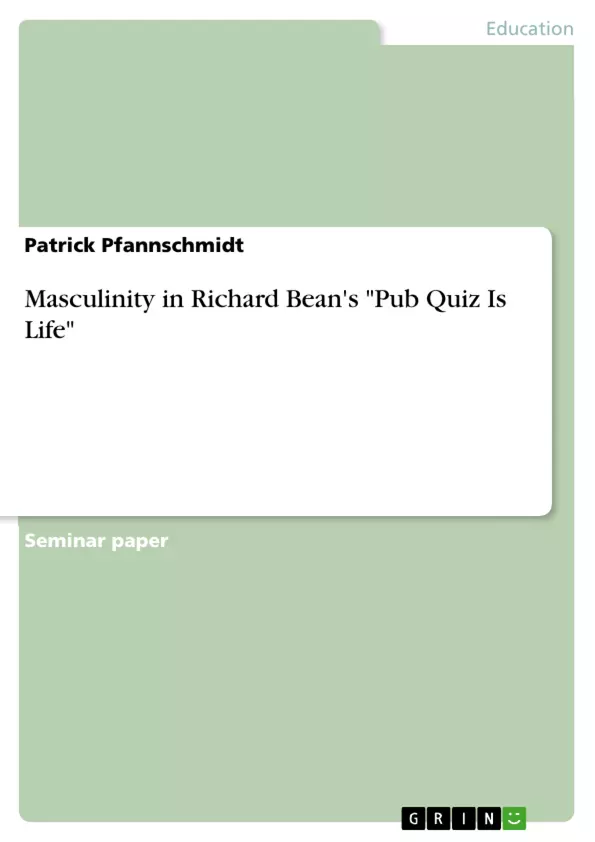Richard Bean is a British comedian and author of several theatre plays, which can be categorized as contemporary literature. His work “Pub Quiz Is Life” is about the veteran Lee, who, together with his father Bunny, his friend Woody and pretty Melissa, initiates a Pub Quiz Team in order to form a opponent team against the teachers’ frequently winning team.
In this paper, I want to work out how Bean uses different literary style elements for bringing up metaphors of masculinity and mankind in “Pub Quiz Is Life” to the audience. Primarily, I want to illustrate masculinity by the stage directions of the play to show that the different settings transport virile moods. In a second step, I want to put focus on the three male characters of the play. Lee, Bunny and Woody have different versions in expressing maningful behavior. In this part, I want to present several text passages which will be undergirded with the representation theory of the Canadian sociologist Erving Goffman. There are several songs, bands, and musicians presented in the play in different ways. Music is a very powerful medium to transport moods and feelings to the audience, regardless of whether they are given in stage directions or text passages in a book or if they are played on stage as background music or sung by some actor. Thus, this paper is a written work on a written play, which is not hearable in consequence. In this last part, I will work with text passages of the play, with lyrics of several given songs, and with the images and historical backgrounds of the bands and musicians.
Table of Contents
- Introduction
- Masculinity In the Play "Pub Quiz Is Life"
- The Settings
- The Pub
- The Range Rover
- The Street
- Bunny's Flat
- Masculine Behavior Expressed by Lee, Bunny and Woody
- Lee
Objectives and Key Themes
This paper examines how Richard Bean utilizes various literary style elements in his play "Pub Quiz Is Life" to convey metaphors of masculinity and manhood to the audience. It focuses on the themes of masculinity, camaraderie, and the representation of male characters in a working-class setting. The analysis considers the stage directions, character dialogue, and musical choices within the play.
- Masculinity in the context of working-class British culture
- The role of setting and stage directions in shaping the audience's perception of masculinity
- The portrayal of masculinity through character dialogue and interaction
- The influence of music and its symbolism in conveying masculine themes
- The exploration of contrasting expressions of masculinity through the characters of Lee, Bunny, and Woody
Chapter Summaries
The introduction provides background information on Richard Bean's life and work, highlighting his focus on male camaraderie in his plays. The paper then outlines the three main approaches used to explore masculinity in "Pub Quiz Is Life": the play's settings, the male characters' actions, and the chosen music. The paper then explores the various settings in the play, such as the pub, the Range Rover, the street, and Bunny's flat, and how they contribute to the portrayal of masculinity. The chapter on masculine behavior focuses on the character of Lee, analyzing his dialogue and actions in the play and how they demonstrate masculine attributes such as camaraderie, ambition, and the desire to prove his worth.
Keywords
The main keywords and focus topics include: masculinity, working-class culture, British playwriting, Richard Bean, "Pub Quiz Is Life", stage directions, character dialogue, music, symbolism, camaraderie, Erving Goffman, representation theory, male characters, Lee, Bunny, Woody.
- Quote paper
- Patrick Pfannschmidt (Author), 2014, Masculinity in Richard Bean's "Pub Quiz Is Life", Munich, GRIN Verlag, https://www.hausarbeiten.de/document/281813


